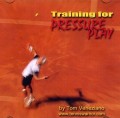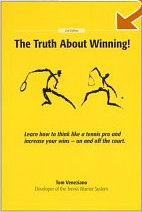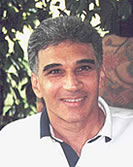QUESTION: On your groundstrokes, should you take the racket back as soon as the ball comes your way?
ANSWER: Absolutely not!
Some of you still fall prey to this false information about taking the racket back quickly. If you hit the ball late and miss, you immediately think that you should have jammed the racket back sooner. Here is my question to you. If you have the habit of immediately taking the racket back then what are you going to do when the ball comes at you rocket-fast? There is no time to take a big back swing. You must modify your stroke quickly. But how can you when the racket is all the way back as commonly taught? There is just not enough time to then shorten up the swing for the faster balls! This means you should learn instinctively to prepare differently for different shots.
The one-size-fits-all type of backswing will not work, so stop thinking about jamming the racket back when the ball is coming to you. This is too mechanical and robotic. You must learn to be more instinctive and automatic. How? Take the racket back when you are about to hit the ball, not while you are running to hit the ball. Preparing the racket just before or after the ball bounces is more natural. Better yet, do not even think about the backswing and just let it happen. With practice your timing will improve and so will your backswing.
Do you think I have gone wacky? Not so! At least not in the way you think. Here is another question for you. Have you ever seen a pro take his racket back then proceed to run with the racket hanging behind him? Watch the pros the next time and see what you think.
You will be surprised to discover the racket goes back as they are about to hit. They may have a slight turn in the direction they are running, but the full swing begins when they are about to hit. It is time to begin playing more like a pro. Do not fall for the rigid, conventional method of taking the racket back like a robot. I'm not sure where this came from, but it's a myth. This technique does not hold up under true playing application.
One of the reasons the pros take the racket back later than you would have expected is because it is more natural to run to meet the ball with the racket in front of you rather than wagging behind. Running fast with the racket dangling behind is just too awkward. I usually demonstrate to my students how silly it looks to run to meet the ball with the racket already back. Then I ask if they have ever seen a pro look like that. They usually laugh. The pros may take a slight turn in the direction of the ball, but the racket does not go all the way back until they are ready to hit the ball.
Another reason the pros wait to take the racket back is because the backswing is part of the timing and rhythm of hitting the ball. The timing and rhythm are essential for power on their groundstrokes. If the racket is back too soon the pros become too mechanical and will lose the rhythm, the feel, and the power. Unbeknownst to most players tennis is more a game of timing and rhythm than of perfect mechanics. That's why John McEnroe with his totally unconventional strokes was number one in the world!
The lesson here is to stop over-thinking taking the racket back. As I said earlier, if I were you I would not even THINK about taking the racket back, just let it happen naturally. The more you practice letting the racket go back naturally, the better your timing and rhythm will become. That's right, you must practice, there is no shortcut. Players all around the world are being taught to take their racket back immediately, but they are still hitting the ball late! Why? Because timing is not a technique, it's acquired by many hours of practice. You may have the racket back before the ball arrives in your hitting zone, but with poor timing this is meaningless. Do not fall prey to the traditional advice of jamming the racket back quickly. You will improve much faster, have one less thing to think about and avoid paralysis by analysis!










 You will join 13,000 other subscribers in receiving news of updates to the Tennis Server along with monthly tennis tips from tennis pro Tom Veneziano.
You will join 13,000 other subscribers in receiving news of updates to the Tennis Server along with monthly tennis tips from tennis pro Tom Veneziano. 